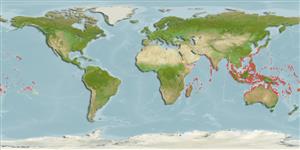Common names from other countries
Environment: milieu / climate zone / depth range / distribution range
Ecologia
Associadas(os) a recifes; intervalo de profundidade 0 - 6 m (Ref. 96667). Tropical; 36°N - 33°S, 29°E - 134°W
Indo-Pacific: north from Japan, China, Taiwan to southeast Asia, west to Australia, Christmas Island, Cocos (Keeling) Islands to India, Oman and east Africa.
Length at first maturity / Tamanho / Peso / Idade
Maturity: Lm ? range ? - ? cm Max length : 8.0 cm CW macho/indeterminado; (Ref. 343)
Carapace is oval in shape which is covered with tubercles. The frontal margin has six or more spines. Pair of pincers are unequal in size and are covered with very tiny granules (Ref. 128968).
Adults are found in rock cracks in shallow waters. They display aggressive and nocturnal behaviour (Ref. 128968). Collected for food. Occasionally mildly poisonous in some parts of its range. Mildly poisonous (Ref. 79155). Inhabits rocky shore or reefs. Benthic. Subtropical and tropical climates (Ref. 343). Intertidal (Ref. 106854). Also occurs on algal mat (Ref. 106227). Found within crevices in rocks or coral reefs (Ref. 79155). Observed on mangrove trees (Ref. 74547). Has large master claws with molariform teeth used to crush shells of snails and hermit crabs (Ref. 107019). Observed to open large Turbo sp. Shells in order to extract the terrestrial hermit crab Coenobita perlatus (Ref. 76500).
Life cycle and mating behavior
Maturidade | Reprodução | Desova | Ovos | Fecundidade | Larvas
Members of the order Decapoda are mostly gonochoric. Mating behavior: Precopulatory courtship ritual is common (through olfactory and tactile cues); usually indirect sperm transfer.
Ng, P.K.L. 1998. (Ref. 343)
Status na Lista Vermelha da IUCN (Ref. 130435)
Status no CITES (Ref. 108899)
Not Evaluated
Not Evaluated
Perigo para os humanos
Poisonous to eat (Ref. 128968)
Uso pelos humanos
Pescarias: espécies comerciais
| FishSource | Sea Around Us
Ferramentas
Fontes da internet
Estimates based on models
Preferred temperature
(Ref.
115969): 24.8 - 29.3, mean 28.4 (based on 3372 cells).
Resiliência
Elevada, tempo mínimo de duplicação da população menor que 15 meses (K=0.68).
Vulnerabilidade
Low vulnerability (10 of 100).
Categoria de preço
Unknown.
